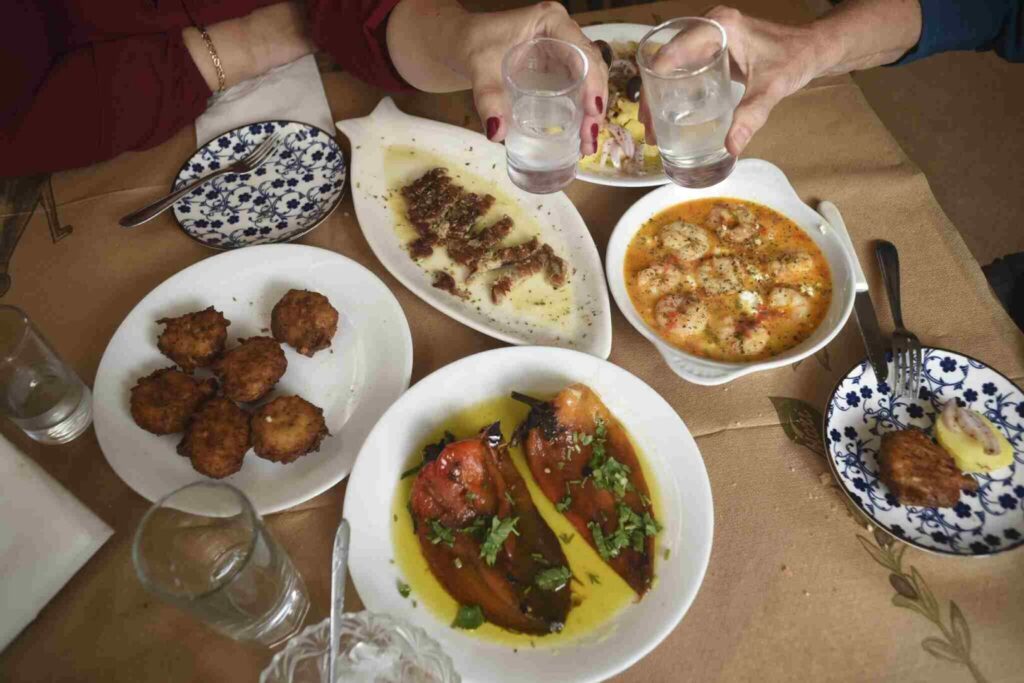In Greece, food is far more than sustenance — it’s a way of connecting, celebrating, and slowing down to savour the moment. Nowhere is this spirit more deliciously expressed than in the country’s meze culture.
Greek meze (plural mezedes) are small plates meant for sharing, a vibrant collection of flavours and textures that transform a simple drink or conversation into a feast. In Greek cuisine, meze are appetisers, often served as the first course or throughout the meal to encourage communal dining. They are the essence of Greek hospitality — unhurried, generous, and endlessly varied. Whether you’re sipping ouzo by the Aegean, enjoying wine in a mountain village, or nibbling on olives in a bustling city bar, great meze offer shareable, flavorful small bites ideal for social gatherings. Meze invites you to taste Greece one small bite at a time.
What Is Meze?
The word meze refers not only to appetisers before a meal, but to a meal in itself — a social experience built around many small dishes shared with friends and family.
Similar to Spanish tapas, meze consists of small plates or dishes served as appetisers or meals, often shared among friends, emphasising the communal enjoyment of flavorful food.
Each plate is designed to complement the drink it accompanies. Anise-flavoured ouzo or tsipouro (grape spirit) pairs beautifully with salty or tangy bites, such as grilled octopus or marinated anchovies. Greek Wine pairs well with earthy flavours such as cheeses, roasted vegetables, and baked casseroles. Beer goes hand in hand with fried snacks or spicy dips.
The idea is not to fill up quickly but to linger — to talk, laugh, toast, and let the table evolve slowly as new dishes arrive. Eating meze is a leisurely, social experience that highlights the flavours and cultural significance of Greek cuisine.
The Social Soul of Greek Dining
In Greece, meals are a communal ritual. Greeks have developed a unique tradition of sharing meze, setting their approach apart from other Mediterranean cultures. To sit at a table laden with mezedes is to participate in parea — a cherished concept meaning “the joy of good company.”
There’s no rush. A meze table might begin with olives and bread, then expand to dips, cheeses, seafood, and warm dishes as conversation deepens. Each meze dish contributes to the communal experience, inviting everyone to share in the flavours and stories. Friends come and go, plates are refilled, and glasses are raised often with the words “Yamas!” (cheers).
In this rhythm, meze embody the Greek approach to life: simplicity, abundance, and connection. Food is a bridge between generations, regions, and strangers who become friends over shared plates.
A Taste of Tradition: The Building Blocks of Meze
Every Greek table tells a story of place — mountains, sea, and sun. Meze draws upon local produce, seasonal ingredients, and time-honoured recipes that vary from one island to another. Many meze dishes are based on traditional Greek recipes that have been passed down through generations, each offering a unique taste of regional culture. The use of spice in meze also enhances flavours and creates variety, making each dish more inviting and flavorful.
Below are some essential dishes that define the meze experience across Greece:
1. Olives and Olive Oil
The simplest yet most essential start. Every meal begins with a small plate of local olives — perhaps wrinkled black throubes from Thassos, green Amfissa olives from central Greece, or classic Greek Kalamata olives often included in meze — often drizzled with fruity extra-virgin olive oil and sprinkled with oregano.
Bread or paximadia (barley rusks) are always nearby for dipping.
2. Greek Dips and Spreads
No meze table is complete without a colourful array of dips:
- Tzatziki – creamy Greek yoghurt, cucumber, garlic, and dill
- Melitzanosalata – smoky roasted eggplant with olive oil and lemon
- Tirokafteri – spicy feta cheese dip with chilli
- Taramosalata – smooth pink fish roe blended with bread, olive oil, and often onion to enhance the flavour
- Fava Santorinis – velvety yellow split pea puree topped with capers and onions
These dips are typically served with warm pita bread or crisp vegetables — simple, fresh, and bursting with flavour.
3. Greek Cheeses
Cheese is a cornerstone of Greek meze. Beyond the famous feta, each region boasts its own treasures:
- Graviera – sweet, nutty cheese from Crete or Naxos
- Kefalotyri – salty and firm, perfect for frying into saganaki
- Feta – salty, white goat cheese often found in Greek Salads
- Mizithra – soft, tangy cheese used in pies or served fresh
Cheese is often paired with tomatoes, cured meats, or a drizzle of olive oil and herbs.
4. The Sea on a Plate
With Greece surrounded by the Aegean and Ionian seas, seafood meze is a must. You’ll find:
- Grilled octopus — smoky and tender, served with lemon and oregano
- Fried calamari — crisp and golden, with a squeeze of lemon
- Marinated anchovies or sardines — cured in vinegar and olive oil
- Gavros tiganitos — tiny fried fish eaten whole, crunchy and addictive
Along the coast, seaside tavernas specialise in seafood meze paired with ouzo or tsipouro, the quintessential Greek experience.
5. Meaty Bites
Though lighter than a main course, meat-based meze packs serious flavour:
- Keftedakia – small spiced Greek meatballs with mint, often made with ground beef or a mix of meats
- Soutzoukakia – mini oblong meatballs in tomato and cinnamon sauce, traditionally filled with ground beef
- Loukaniko – orange- and herb-flavoured Greek sausage
- Paidakia – grilled lamb chops served with lemon
Turkey is sometimes used as a leaner alternative in Greek meatball and kofta recipes.
Fresh salads or dips often balance these savoury dishes, refreshing the palate.
6. Vegetarian Delights
Greek meze is a paradise for vegetarians thanks to the abundance of vegetables, legumes, and herbs:
- Dolmadakia – vine leaves stuffed with rice and herbs
- Gigantes Plaki – giant baked beans in tomato sauce
- Kolokithokeftedes – zucchini fritters with mint and feta
- Spanakopita – spinach and cheese pie wrapped in flaky filo
- Peppers Florinis – sweet red peppers stuffed with cheese or breadcrumbs
These dishes highlight the Mediterranean balance between indulgence and health — proof that Greek food can be both hearty and wholesome.
7. Bread, Rusks, and Pita
Bread is not just an accompaniment; it’s an essential utensil for scooping, dipping, and savouring. In Crete, dakos — barley rusks topped with tomatoes, feta, and olive oil — is a beloved meze on its own.
Warm pita or village bread keeps the table connected — everyone reaching, dipping, and sharing from the same dishes.
Creating a Meze Table
Creating a meze table is a true celebration of Greek cuisine and the spirit of togetherness. The word “meze” means “taste” or “bite,” and the meze table is all about sharing a variety of small dishes served with love and generosity. To start, lay out a selection of traditional Greek meze: bowls of creamy tzatziki, earthy hummus, and a fiery spicy feta dip, all ready for scooping with warm pita bread. Drizzle everything with golden olive oil and sprinkle with dried oregano for that unmistakable Greek flavour.
No meze table is complete without a medley of Greek dips—think velvety fava beans, smoky eggplant salad, and the briny pop of fish roe dip. Arrange cubes of feta cheese, plump olives, and crisp fresh vegetables for easy nibbling. For heartier bites, add grilled octopus, juicy lamb kofta, or tender meatballs, each bursting with herbs and a squeeze of lemon juice. And of course, a classic Greek salad—tossed with tomatoes, cucumbers, onions, feta, and a generous splash of olive oil—brings freshness and colour to the spread.
The beauty of the meze table lies in its variety and abundance. Mix and match your favourite small dishes, experiment with new flavours, and invite everyone to dig in. Whether you’re hosting a casual gathering or a festive Greek feast, the meze table is a delicious way to savour the flavours and hospitality of Greece, one small plate at a time.
Meze Platter Ideas
A Greek meze platter is the ultimate showcase of Greek food—colourful, inviting, and packed with bold flavours. Start by arranging warm pita bread slices and a rainbow of fresh vegetables, such as cucumbers, peppers, and cherry tomatoes. Add a selection of cheeses, from creamy feta to gooey melted cheese, to anchor your platter with rich, tangy notes.
Next, fill small bowls with classic Greek dips: cool tzatziki, smooth hummus, and a zesty spicy feta dip. For protein, include juicy meatballs, grilled lamb skewers, or tender chicken pieces. Stuffed grape leaves and golden zucchini fritters add a touch of tradition and texture, while small plates of rice or roasted vegetables make the platter more substantial.
Don’t forget the little extras that make a meze platter special—plump olives, crunchy pine nuts, and a scattering of fresh herbs like dill, mint, and parsley. A traditional Greek salad, bursting with tomatoes, cucumbers, onions, and feta, can be served alongside or right on the platter for a burst of freshness. For a finishing touch, drizzle everything with olive oil and a squeeze of lemon, and serve with plenty of bread for dipping and sharing.
Whether you’re serving a cosy family meal or hosting a lively Greek feast, a meze platter brings people together with its variety of small plates and big flavours. It’s a delicious, interactive way to experience the warmth and abundance of Greek cuisine—one bite at a time.
Drinks That Define the Meze Experience
Every region has its drink of choice to go with meze:
- Ouzo – the anise-flavoured spirit of the Aegean, best sipped slowly over ice
- Tsipouro – grape pomace spirit from the north, sometimes infused with anise
- Raki (or tsikoudia) – Crete’s strong, clear brandy, often homemade
- Local wines – crisp whites like Assyrtiko or light reds from Nemea
- Beer and retsina – refreshing companions for fried or spicy dishes
Drinks and meze are inseparable. In fact, many tavernas won’t serve alcohol without food — the flavours are meant to enhance each other, never overpower.
Regional Meze Traditions
Greece’s geography and history create remarkable regional diversity:
- Crete: Meze here celebrates simplicity — olives, rusks, graviera cheese, and wild greens drizzled with oil and lemon.
- Macedonia: Rich flavours dominate — spicy sausages, grilled peppers, and hearty bean dishes.
- Cyclades Islands: Expect more seafood, capers, and sun-dried tomatoes.
- Epirus: Mountain villages offer earthy meze like pies, cured meats, and mushrooms.
- The Dodecanese: Turkish influences are evident in dishes such as soutzoukakia and yoghurt dips. Some meze dishes from this region also reflect broader Middle Eastern culinary traditions.
Each region mirrors its landscape — rugged, fertile, or coastal — and the meze brings those characteristics to life on the plate. Greek meze shares similarities with dishes from the Middle East and other Middle Eastern cuisines, highlighting the multicultural influences that shape these small plates.
The Art of Sharing
There is no right or wrong way to enjoy meze. Dishes arrive as they’re ready, filling the table in a casual, abundant spread. Everyone shares, often using bread to scoop or tasting directly from the plate. A sprinkle of salt is frequently added as a finishing touch to each dish, enhancing the flavour and bringing out the best in the ingredients.
Unlike a formal meal, meze are spontaneous and social. They encourage conversation, laughter, and lingering — sometimes lasting hours. The goal is never just to eat but to connect.
As one Greek saying goes, “When you eat alone, you eat half. When you eat with friends, you eat double.”
From Ancient Symposia to Modern Taverns
The roots of meze can be traced back to ancient Greece, where banquets (symposia) featured small dishes paired with wine and philosophical conversation. The Byzantines continued this tradition, incorporating exotic spices and sweets from the East.
During Ottoman times, the concept of sharing small plates over drinks flourished throughout the Mediterranean, and Greece made it uniquely its own — rustic, seasonal, and centred on friendship.
Today, meze culture thrives not just in traditional tavernas but in modern mezedopolia — contemporary bars that reinvent classics with creative flair. Whether in Athens’ Psyrri district or a village square in Crete, the meze table remains a symbol of connection through food.
A Toast to Meze — and to Life
Greek meze culture is a masterclass in simplicity and balance. Each plate tells a story of land and sea, of family and festivity, of generations gathered around the table. It’s food meant to be shared — unpretentious, flavorful, and full of heart.
So next time you sit down in Greece, skip the rush of a single main course. Order a few small plates, pour a glass of ouzo, and join the slow rhythm of conversation and laughter. Because in Greece, the best meals aren’t about how much you eat — they’re about who you share them with. Yamas! To small plates, big flavour, and the endless joy of Greek meze.




